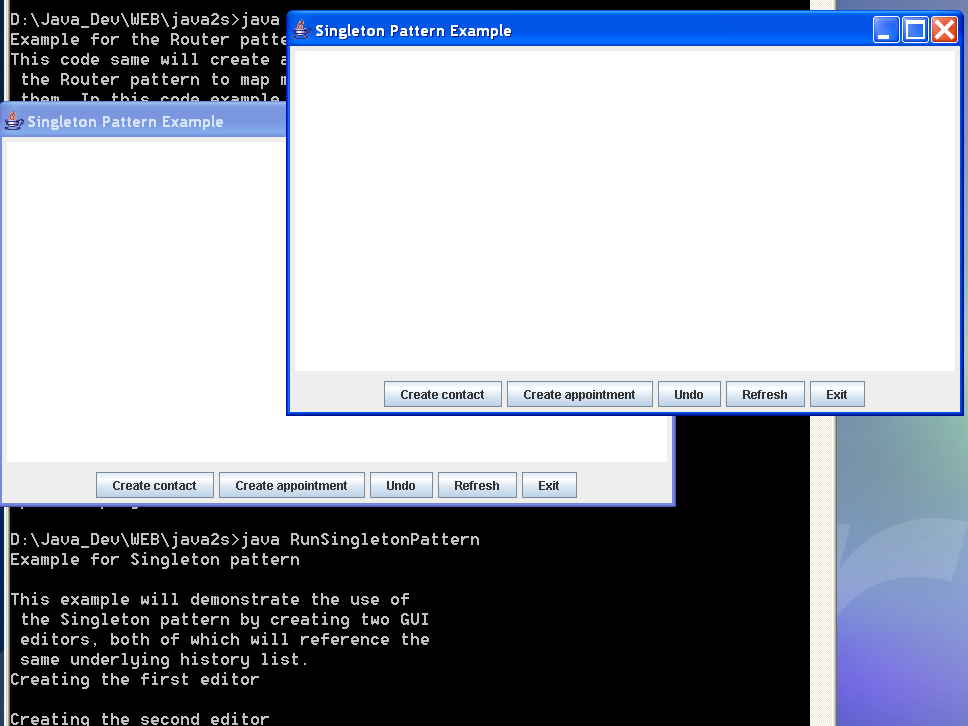Singleton Pattern 2

//[C] 2002 Sun Microsystems, Inc.---
import java.awt.Container;
import java.awt.event.ActionEvent;
import java.awt.event.ActionListener;
import java.awt.event.WindowAdapter;
import java.awt.event.WindowEvent;
import java.util.ArrayList;
import java.util.Collections;
import java.util.List;
import javax.swing.BoxLayout;
import javax.swing.JButton;
import javax.swing.JFrame;
import javax.swing.JPanel;
import javax.swing.JTextArea;
public class RunSingletonPattern {
public static void main(String[] arguments) {
System.out.println("Example for Singleton pattern");
System.out.println();
System.out.println("This example will demonstrate the use of");
System.out.println(" the Singleton pattern by creating two GUI");
System.out.println(" editors, both of which will reference the");
System.out.println(" same underlying history list.");
System.out.println("Creating the first editor");
System.out.println();
SingletonGui editor1 = new SingletonGui();
editor1.createGui();
System.out.println("Creating the second editor");
System.out.println();
SingletonGui editor2 = new SingletonGui();
editor2.createGui();
}
}
class SingletonGui implements ActionListener {
private JFrame mainFrame;
private JTextArea display;
private JButton newContact, newAppointment, undo, refresh, exit;
private JPanel controlPanel, displayPanel;
private static int historyCount;
public void createGui() {
mainFrame = new JFrame("Singleton Pattern Example");
Container content = mainFrame.getContentPane();
content.setLayout(new BoxLayout(content, BoxLayout.Y_AXIS));
displayPanel = new JPanel();
display = new JTextArea(20, 60);
display.setEditable(false);
displayPanel.add(display);
content.add(displayPanel);
controlPanel = new JPanel();
newContact = new JButton("Create contact");
newAppointment = new JButton("Create appointment");
undo = new JButton("Undo");
refresh = new JButton("Refresh");
exit = new JButton("Exit");
controlPanel.add(newContact);
controlPanel.add(newAppointment);
controlPanel.add(undo);
controlPanel.add(refresh);
controlPanel.add(exit);
content.add(controlPanel);
newContact.addActionListener(this);
newAppointment.addActionListener(this);
undo.addActionListener(this);
refresh.addActionListener(this);
exit.addActionListener(this);
mainFrame.addWindowListener(new WindowCloseManager());
mainFrame.pack();
mainFrame.setVisible(true);
}
public void refreshDisplay(String actionMessage) {
display.setText(actionMessage + "\nCOMMAND HISTORY:\n"
+ HistoryList.getInstance().toString());
}
public void actionPerformed(ActionEvent evt) {
Object originator = evt.getSource();
if (originator == newContact) {
addCommand(" New Contact");
} else if (originator == newAppointment) {
addCommand(" New Appointment");
} else if (originator == undo) {
undoCommand();
} else if (originator == refresh) {
refreshDisplay("");
} else if (originator == exit) {
exitApplication();
}
}
private class WindowCloseManager extends WindowAdapter {
public void windowClosing(WindowEvent evt) {
exitApplication();
}
}
private void addCommand(String message) {
HistoryList.getInstance().addCommand((++historyCount) + message);
refreshDisplay("Add Command: " + message);
}
private void undoCommand() {
Object result = HistoryList.getInstance().undoCommand();
historyCount--;
refreshDisplay("Undo Command: " + result);
}
private void exitApplication() {
System.exit(0);
}
}
class HistoryList {
private List history = Collections.synchronizedList(new ArrayList());
private static HistoryList instance = new HistoryList();
private HistoryList() {
}
public static HistoryList getInstance() {
return instance;
}
public void addCommand(String command) {
history.add(command);
}
public Object undoCommand() {
return history.remove(history.size() - 1);
}
public String toString() {
StringBuffer result = new StringBuffer();
for (int i = 0; i < history.size(); i++) {
result.append(" ");
result.append(history.get(i));
result.append("\n");
}
return result.toString();
}
}
Related examples in the same category